Fiddleheads are a delicious wild Spring vegetable, only available for two or three weeks of the year. Their short availability makes them quite expensive if you don't want to forage for them yourself. Since fiddleheads don't particularly store well fresh, freezing fiddleheads is a great way to store them for use later in the year.
Fiddleheads are great sauteed with onions, and garlic, make a great side for grilled meats, fish, and shellfish, and are super tasty in pasta dishes! Follow these simple steps to enjoy fiddleheads year round!
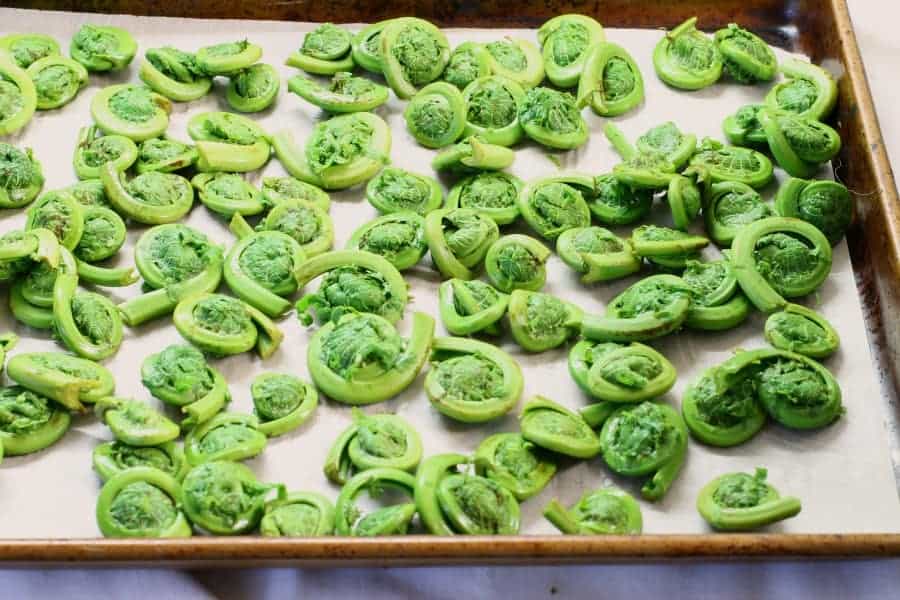
Some of the links in this post lead to affiliate sites through which Earth, Food, and Fire may earn a small commission should you make a purchase. For more info check the Affiliate Disclaimer. All advice, and opinions are based on observations from my own garden and experiences.
How Long Can You Keep Fiddleheads In The Fridge?
Fiddleheads are the very young shoots of the Ostrich Fern, and grow across North America in wet, wild woodlands. This is of course an ideal breeding ground for bacteria, and mold, making fresh fiddleheads susceptible to rot, and spoiling quickly.
Cleaning and storing fiddleheads properly can help extend their shelf life, but even so, they usually only last about a week before going bad under regular refrigeration. You can extend this to a couple weeks by first cleaning the fiddleheads extremely well, and then storing them submerged in water in the fridge
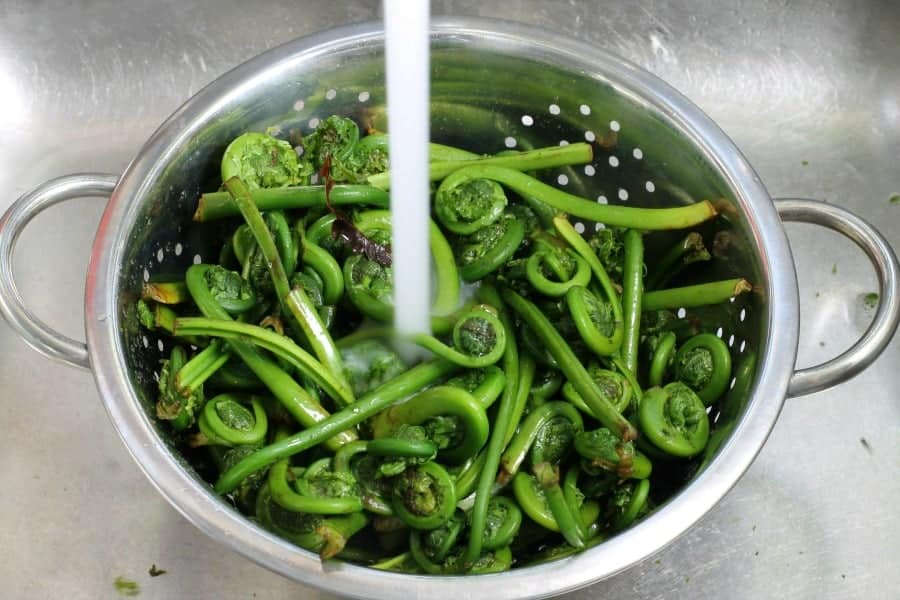
You can also pickle fiddleheads to extend their shelf life by a month or so.
How To Freeze Fiddleheads For Long Term Storage
Freezing fiddleheads is quite easy and is in my opinion the best way to store a large batch of fiddleheads.
You'll need:
- A large pot filled with water
- salt
- cold running water or an ice bath
- a spider or other sieve
- 1-2 lbs cleaned fiddleheads
First you'll need to clean and trim the fiddleheads if you did not purchase them this way. This is followed by blanching them to par-cook the fiddleheads, shocking them in cold water, and finally freezing them. The blanching is done to kill any bacteria that may be present on the fern heads, and they are then shocked to immediately stop the cooking process and prevent over cooking.
Shocking the fiddleheads, (or any blanched vegetable for that matter) also helps set their bright color, and keeps the vegetable looking fresher.
Blanching Fiddleheads
- Set a pot of water on the stove to boil over high heat You'll want to make sure it is large enough to easily fit all the fiddleheads you plan on freezing, as well as excess water.
- Liberally salt the water.
- Once the water is boiling, dump in the fiddleheads, and stir them a few times to evenly distribute them.
- Let the water come back to a boil, and let the fiddleheads cook for 30 seconds.
- Immediately scoop out the fiddleheads and transfer them into an ice bath or run them under cold running water to stop the cooking process.
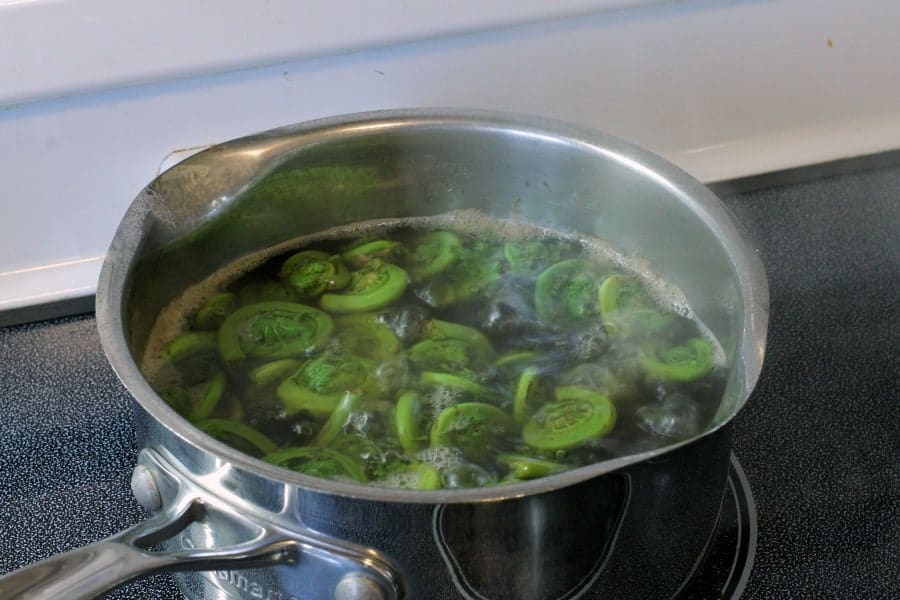
Individually Quick Freeze (IQF) The Fiddleheads
When the fiddleheads have been blanched and cooled, spread them out on a clean dish towel and pat them dry.
- Spread the blanched fiddleheads on a cookie sheet lined with parchment, making sure they are spread out in on even layer.
- Place the tray in the freezer and let the fiddleheads freeze. About 30 minutes.
- Once the fiddleheads are frozen solid, place the frozen fiddleheads in a ziploc feezer bag, or if you have the option, vacuum seal the fiddleheads. Label and date the bags.
- Replace the frozen fiddleheads in the freezer. They will last for up to one year.
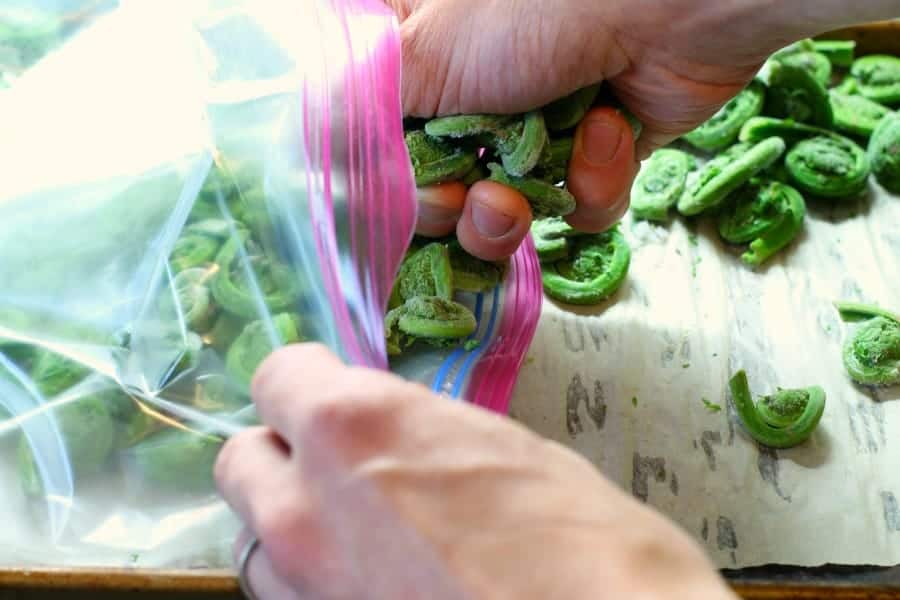
If using ziploc bags to store the IQF fiddleheads, suck out as much air as possible before tightly sealing the bag. This will help prevent freezer burn, and increase the quality of the frozen fiddleheads once thawed. - Chef Markus Mueller
How To Use Frozen Fiddleheads
When you are ready to use your frozen fiddleheads, simply take them out of the freezer and thaw them in the fridge. Once thawed, proceed to use the fiddleheads as you would use fresh ones.
Frozen and thawed fiddleheads should still be cooked for at least 6 to 8 minutes before consuming to help prevent food poisoning.
Do not save and re-use leftovers.
Have you frozen fiddleheads? Rate the method below, and take a picture and tag me on Facebook & Instagram: @earthfoodandfire . For more from scratch recipes follow me on Instagram & Pinterest
Recipe
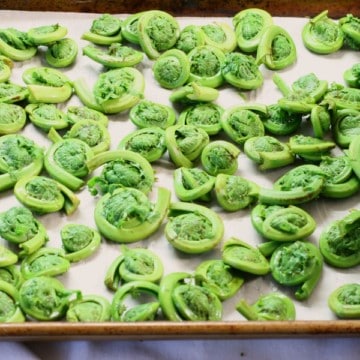
Freezing Fiddleheads
Ingredients
- 1 Large pot filled with water
- 2 tablespoon salt
- cold running water or an ice bath
- 1 spider or other sieve
- 1-2 lbs cleaned fiddleheads
- 1 a cookie sheet lined with parchment
Instructions
Blanching Fiddleheads
- First you'll need to clean and trim the fiddleheads if you did not purchase them this way.
- Set a pot of water on the stove to boil over high heat
- Liberally salt the water
- Once the water is boiling, dump in the fiddleheads, and stir them a few times to evenly distribute them.
- Let the water come back to a boil, and let the fiddleheads cook for 30 seconds.
- Immediately scoop out the fiddleheads and transfer them into an ice bath or run them under cold running water to stop the cooking process.
Freezing The Fiddleheads
- When the fiddleheads have been blanched and cooled, spread them out on a clean dish towel and pat them dry.
- Spread the blanched fiddleheads on a cookie sheet lined with parchment, making sure they are spread out in an even layer.
- Place the tray in the freezer and let the fiddleheads freeze. About 30 minutes.
- Place the frozen fiddleheads in a ziploc feezer bag, or if you have the option, vacuum seal the fiddleheads. Label and date the bags.
Notes
- When you are ready to use your frozen fiddleheads, simply take them out of the freezer and thaw them in the fridge.
- Once thawed, proceed to use the fiddleheads as you would use fresh ones.
- Frozen and thawed fiddleheads should still be cooked for at least 6 to 8 minutes before consuming to help prevent food poisoning.
- Do not save and re-use leftovers.
Nutrition
Nutrition info is auto-generated. This information is an estimate; if you are on a special diet, please use your own calculations.


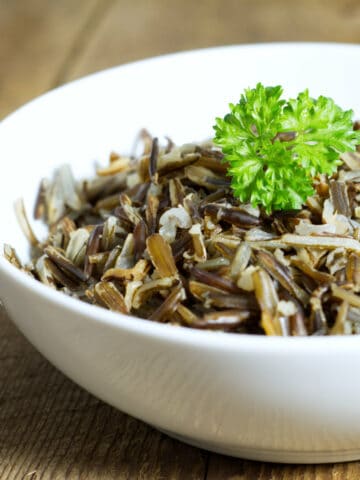
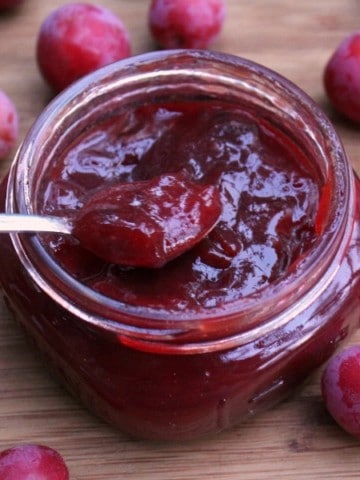
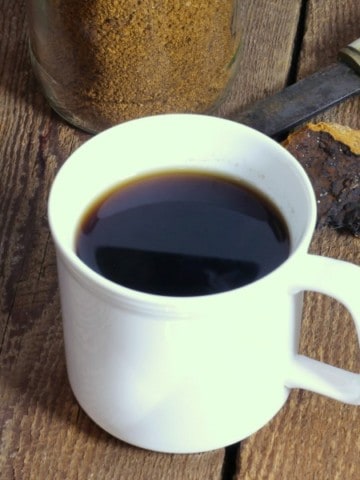
Lori
I recently received fiddleheads from a friend up north. I've cooked them and using some for a quiche. Can I freeze the remainder? They are cooked, not blanched.
Chef Markus Mueller
Hi Lori, yes you can freeze them. Just keep in mind they will be quite soft, and loose some water during the thawing process.
Allie
I have fiddleheads frozen from last year would it be possible to thaw them and can/pickle them?
Chef Markus Mueller
Hi Allie, while you could certainly thaw and pickle them, keep in mind that freezing/thawing the fiddle heads will change their texture and they will naturally be softer and no longer crisp. If you are doing a hot pickle, I would suggest not thawing the fiddleheads first and instead adding the hot pickling liquid directly to the frozen fiddleheads to preserve as much texture as possible.
caroline farus
I am enjoying fiddleheads after many years away. I am now 94 and back in in NE.. a land I love!
andrea
why do you say to not re use leftovers?
Chef Markus Mueller
Hi Andrea, I always advise folks not to re-use leftover cooked fiddle heads, because they are already a 'high-risk' food in regards to food borne illness to begin with (due to their tightly curled nature, bacteria can get caught in the leaves/frilly edges and can be hard to remove). As such as I always advise folks to only cook and eat the amount you will consume in one sitting, to prevent the chances of bacteria multiplying in the leftovers. Of course what you decide to do yourself at home is entirely up to you!
Catie
Last year we ate, and ate, and ate the fiddleheads because we didn't want to waste them. So grateful for these tips. Freezing them now!! Fingers crossed.
Chef Markus Mueller
Now you can enjoy the fiddleheads year round!
Jon Steiger
Thank you for this freezing information. I was introduced to fiddleheads many years ago and always tried to enjoy them during the short season of their availability. Now that I have more time on my hands I am excited about buying them in some quantity and freezing them.
QUESTION: Can the stems be put to any good use. Seems like a lot of waste. Vegetable stock, or diced to add to rice or some such thing?
Chef Markus Mueller
Hi Jon, Glad you finally found a way to enjoy fiddleheads year round! The stems could be used in stock sure. The stems are quite woody, which is why they are removed. As long as they are washed and cooked properly, I don't see why you couldn't eat them though.
Sarmitha Sathiamoorthy
Thanks for this post. I'm a newbie forager and I tried fiddleheads for the first time this year and loved them. I've collected more and the tip to freeze them is a great one.
Chef Markus Mueller
Your welcome! Glad to hear you loved them!